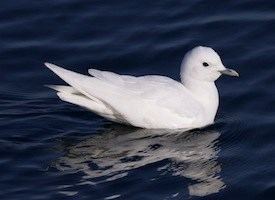Genus PagophilaKaup, 1829 Phylum Chordata Rank Species | Family Laridae Scientific name Pagophila eburnea Higher classification Pagophila Order Shorebirds | |
 | ||
Similar Ross's gull, Sabine's gull, Glaucous gull, Iceland gull, Black‑legged kittiwake | ||
Ivory gull at canal park duluth 01 jan 2016 phs
The ivory gull (Pagophila eburnea) is a small gull, the only species in the genus Pagophila. It breeds in the high Arctic and has a circumpolar distribution through Greenland, northernmost North America, and Eurasia.
Contents
- Ivory gull at canal park duluth 01 jan 2016 phs
- Ivory gull
- Taxonomy
- Description
- Distribution and habitat
- Ecology and behavior
- Diet
- Reproduction
- Status
- References

Ivory gull
Taxonomy

The ivory gull was initially described by Constantine Phipps, 2nd Baron Mulgrave in 1774 as Larus eburneus from a specimen collected on Spitsbergen. Johann Jakob Kaup later recognized the unique traits of the ivory gull and gave it a monotypic genus, Pagophila, in 1829. Johan Ernst Gunnerus later gave the species a new specific name, Pagophila alba. The genus name Pagophila is from Ancient Greek pagos, "sea-ice", and philos, "-loving", and specific eburnea is Latin for "ivory-coloured", from ebur, "ivory". Today some authors consider the ivory gull not deserving of its monotypic genus, instead choosing to merge it, along with the other monotypic gulls, back into Larus. However, most authors have not chosen to do so. The ivory gull has no subspecies. No fossil members of this genus are known.

This gull has traditionally been believed to be most closely related to either the kittiwakes, Sabine's gull, or Ross's gull. It differs anatomically from the other genera by having a relatively short tarsometatarsus, a narrower os pubis, and potentially more flexibility in skull kinetic structure. Structurally, it is most similar to the kittiwakes; however, recent genetic analysis based on mtDNA sequences shows that Sabine's gull is the ivory gull's closest relative, followed by the kittiwakes, with Ross's gull and swallow-tailed gull sharing a clade with these species. "Pagophila" is maintained as a unique genus because of the bird’s morphological, behavioral and ecological differences from these species.
Description

This species is easy to identify. At 43 centimetres (17 in), it has a different, more pigeon-like shape than the Larus gulls, but the adult has completely white plumage, lacking the grey back of other gulls. The thick bill is blue with a yellow tip, and the legs are black. Its cry is a harsh eeeer. Young birds have a dusky face and variable amounts of black flecking in the wings and tail. The juveniles take two years to attain full adult plumage. There are no differences in appearance across the species’ geographic range.
Distribution and habitat
In North America, it only breeds in the Canadian Arctic. Seymour Island, Nunavut is home to the largest known breeding colony, while Ellesmere, Devon, Cornwallis, and north Baffin islands are known locations of breeding colonies. It is believed that there are other small breeding colonies of less than six birds that are still undiscovered. There are no records of the ivory gull breeding in Alaska.
During the winter, ivory gulls live near polynyas, or a large area of open water surrounded by sea ice. North American birds, along with some from Greenland and Europe, winter along the 2000 km of ice edge stretching between 50° and 64° N from the Labrador Sea to Davis Strait that is bordered by Labrador and southwestern Greenland. Wintering gulls are often seen on the eastern coasts of Newfoundland and Labrador and occasionally appear on the north shore of the Gulf of St. Lawrence and the interior of Labrador. It also winters from October through June in the Bering Sea and Chukchi Seas. It is most widespread throughout the polynyas and pack ice of the Bering Sea. It is also vagrant throughout coastal Canada and the northeastern United States, though records of individuals as far south as California and Georgia have been reported, as well as The British Isles, with most records from late November through early March. Juveniles tend to wander further from the Arctic than adults.
Ecology and behavior
Ivory gulls migrate only short distances south in autumn, most of the population wintering in northern latitudes at the edge of the pack ice, although some birds reach more temperate areas.
Diet
It takes fish and crustaceans, rodents, eggs and small chicks but is also an opportunist scavenger, often found on seal or porpoise corpses. It has been known to follow polar bears and other predators to feed on the remains of their kills.
Reproduction
The ivory gull breeds on Arctic coasts and cliffs, laying one to three olive eggs in a ground nest lined with moss, lichens, or seaweed.
Status
In 2012 the total population of ivory gulls was estimated to be between 19,000 and 27,000 individuals. The majority of these were in Russia with 2,500–10,000 along the Arctic coastline, 4,000 on the Severnaya Zemlya archipelago and 8,000 on Franz Josef Land and Victoria Island. There were also estimated to be around 4,000 individuals in Greenland and in the years 2002–03, 500–700 were recorded in Canada. Examination of data collected on an icebreaker plying between Greenland and Svalbard between 1988 and 2014, by Claude Joiris of the Royal Belgian Institute of Natural Sciences, found a sevenfold fall in ivory gull numbers after 2007. The species is rapidly declining in Canada, while in other parts of its range its population is poorly known. The Canadian population in the early 2000s were approximately 80% lower than in the 1980s.
Illegal hunting may be one of the causes of the decline in the Canadian population, and a second cause may be the decline in sea ice. Ivory gulls breed near to sea ice and the loss may make it difficult to feed their chicks.
The species is classified by the International Union for Conservation of Nature as "Near Threatened".
